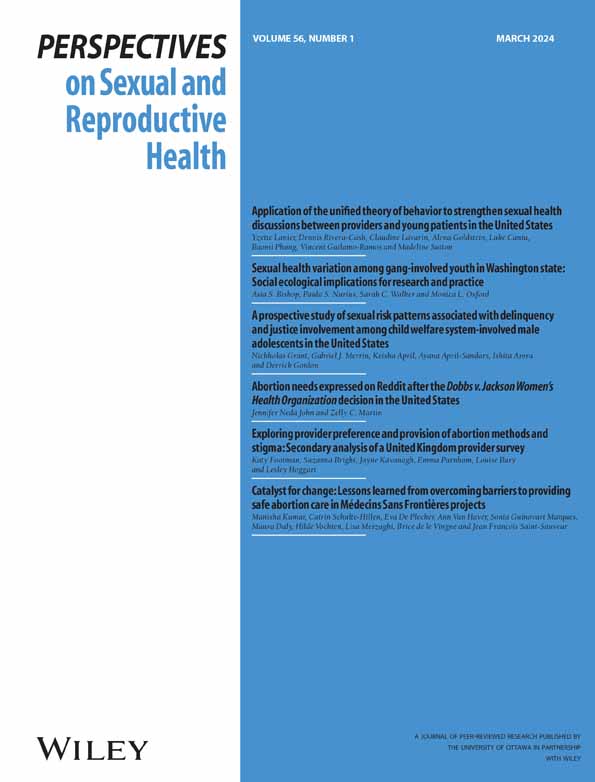Research in brief: How prevalent is rough sex? Results from a national online sample of adults in Germany
IF 3.5
2区 医学
Q1 DEMOGRAPHY
引用次数: 0
Abstract
BackgroundRough sex refers to consensual sexual activities that incorporate playful aggression, such as hair pulling, spanking, or choking. It is relevant in the context of sexual health as it can enhance sexual arousal, pleasure, and intimacy among consenting partners. However, it can also be associated with consent violations, discomfort, and injuries ranging from mild to severe or even fatal. The prevalence of rough sex in Germany is widely unknown. Our study aims to establish, for the first time, the overall age‐related and gender‐related prevalence rates of active and passive rough sex involvement among adults in Germany.MethodsA national online sample of 1101 adults from Germany, aged 18–69 years (50% men, 49% women, 1% gender‐diverse individuals) gave informed consent and reported on their lifetime engagement in rough sex in active and passive roles. We recruited participants through a professional panel provider for a multi‐themed sexual health survey. Data analysis was conducted using R, with 95% confidence intervals of prevalence rates computed to answer the research questions.ResultsLifetime prevalence of rough sex involvement was 29%. Adults below the age of 40 reported higher rates of involvement (up to 43%) than people over 40 (up to 26%). Men reported predominantly active role involvement and women reported primarily passive role involvement.DiscussionResults show that rough sex is common. Sexual health professionals, educators, and researchers should be prepared to guide current and aspiring practitioners of rough sex, helping them understand potential benefits, risks, and age‐ and gender‐related differences.研究简介:粗暴性行为有多普遍?德国成年人全国在线抽样调查结果
背景粗暴性行为是指在双方同意的情况下进行的性活动,其中包含嬉戏性攻击,如扯头发、打屁股或掐脖子。它与性健康息息相关,因为它可以增强性兴奋、快感和双方同意的亲密关系。然而,粗暴性爱也可能导致违反同意、不适和轻微至严重甚至致命的伤害。在德国,粗暴性行为的发生率普遍不为人知。我们的研究旨在首次确定德国成年人中主动和被动粗暴性行为的总体年龄相关和性别相关流行率。方法在全国范围内对 1101 名年龄在 18-69 岁之间的德国成年人(50% 为男性,49% 为女性,1% 为不同性别者)进行在线抽样调查,他们在知情同意的情况下报告了自己一生中主动和被动参与粗暴性行为的情况。我们通过专业小组提供商为一项多主题性健康调查招募参与者。我们使用 R 进行了数据分析,并计算了流行率的 95% 置信区间,以回答研究问题。40 岁以下的成年人报告的参与率(高达 43%)高于 40 岁以上的人群(高达 26%)。男性主要扮演主动角色,而女性则主要扮演被动角色。性健康专业人员、教育工作者和研究人员应做好准备,为目前和未来的粗暴性行为者提供指导,帮助他们了解潜在的益处、风险以及与年龄和性别有关的差异。
本文章由计算机程序翻译,如有差异,请以英文原文为准。
求助全文
约1分钟内获得全文
求助全文
来源期刊
CiteScore
5.10
自引率
3.40%
发文量
24
期刊介绍:
Perspectives on Sexual and Reproductive Health provides the latest peer-reviewed, policy-relevant research and analysis on sexual and reproductive health and rights in the United States and other developed countries. For more than four decades, Perspectives has offered unique insights into how reproductive health issues relate to one another; how they are affected by policies and programs; and their implications for individuals and societies. Published four times a year, Perspectives on Sexual and Reproductive Health includes original research, special reports and commentaries on the latest developments in the field of sexual and reproductive health, as well as staff-written summaries of recent findings in the field.

 求助内容:
求助内容: 应助结果提醒方式:
应助结果提醒方式:


